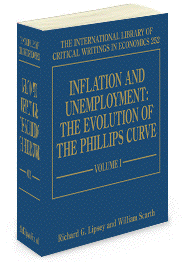Inflation and Unemployment: The Evolution of the Phillips Curve
Three Volumes, (Richard Lipsey and William Scarth editors), (Cheltenham: Edward Elgar) 2011.

These three volumes contain representative articles covering the fifty years of the life of the Phillips Curve that is the 20th century's most cited macroeconomic article. It begins with an introductory essay by the editors that covers: The macro policy debate when Phillips made his contribution, a debate that is largely unknown today; early alternative interpretations the curve; early empirical studies, including those of the loops; the rise of the unique equilibrium doctrine, which covers the consequences of closing the Keynesian model with a simple Phillips curve, and the abandonment of the Keynesian underpinnings of constant marginal costs and short-term relative wage rigidity; the transition from Keynesian to New Classical Economics, which covers the emergence of the expectations-augmented Phillips curve, the New Classical theory in full bloom, the testing of the expectations-augmented Phillips curve, equilibrium and disequilibrium interpretations of the curve, and the drive for more formal micro-foundations.
The essay concludes with a long section on alternative views of the economic process, which contrasts the Newtonian, New Classical view with the Darwinian evolutionary view of the economy. It argues that many of the phenomena that are hard to understand using conventional theory become understandable when viewed through the lens of evolutionary theory − a theory that emphasizes endogenous technological change at the micro-economic level.